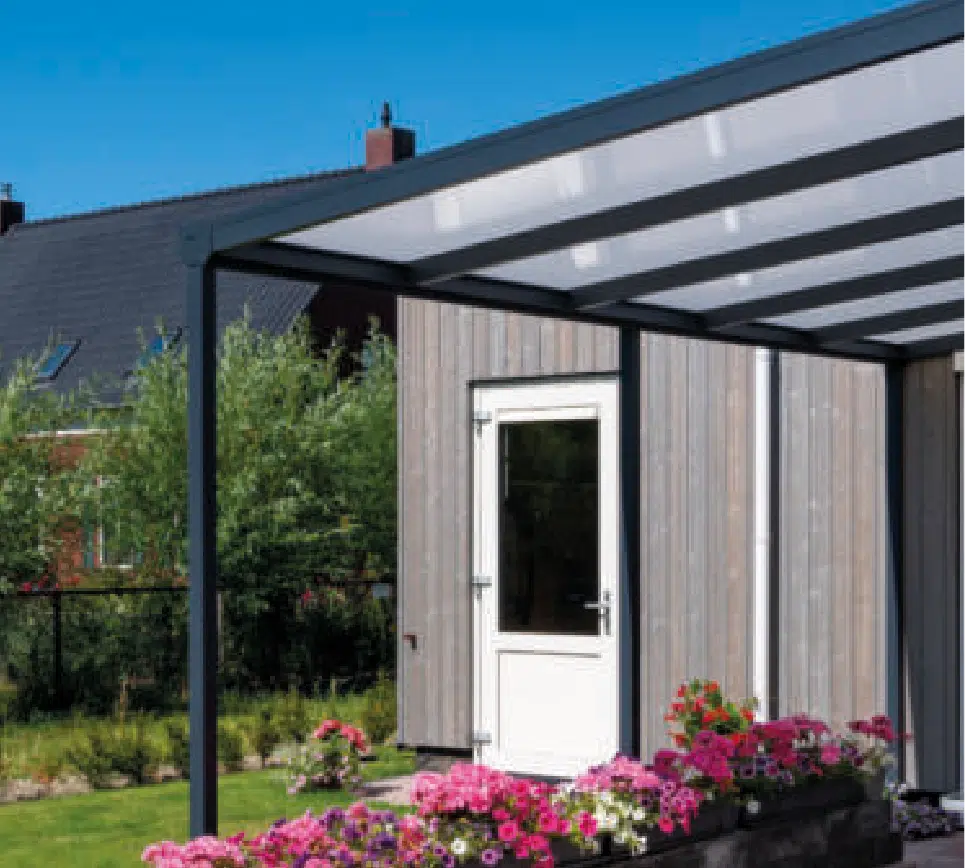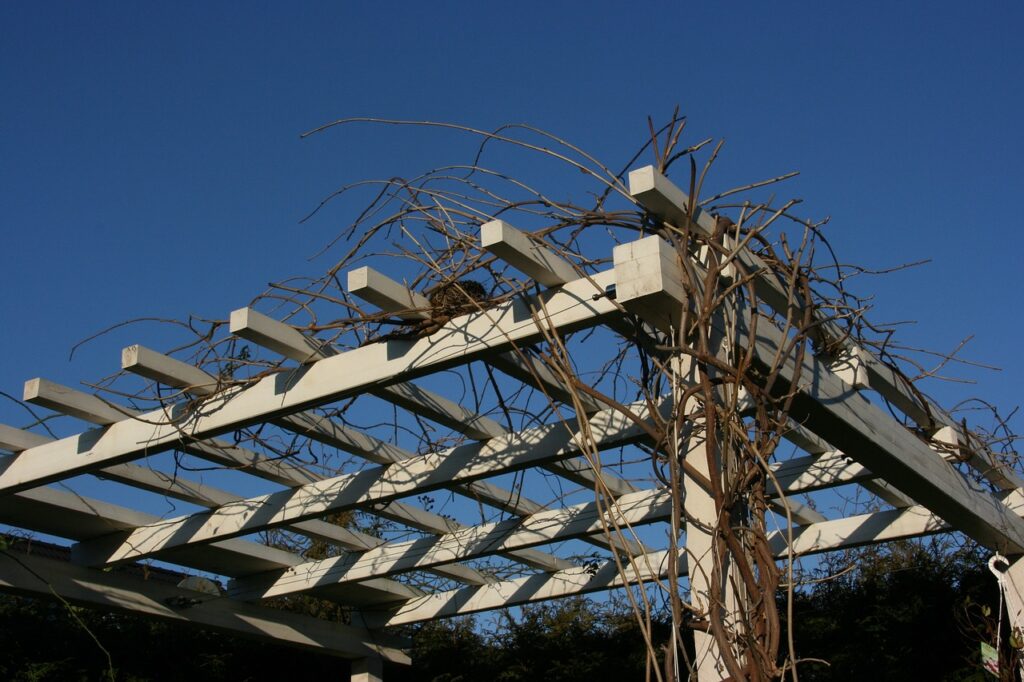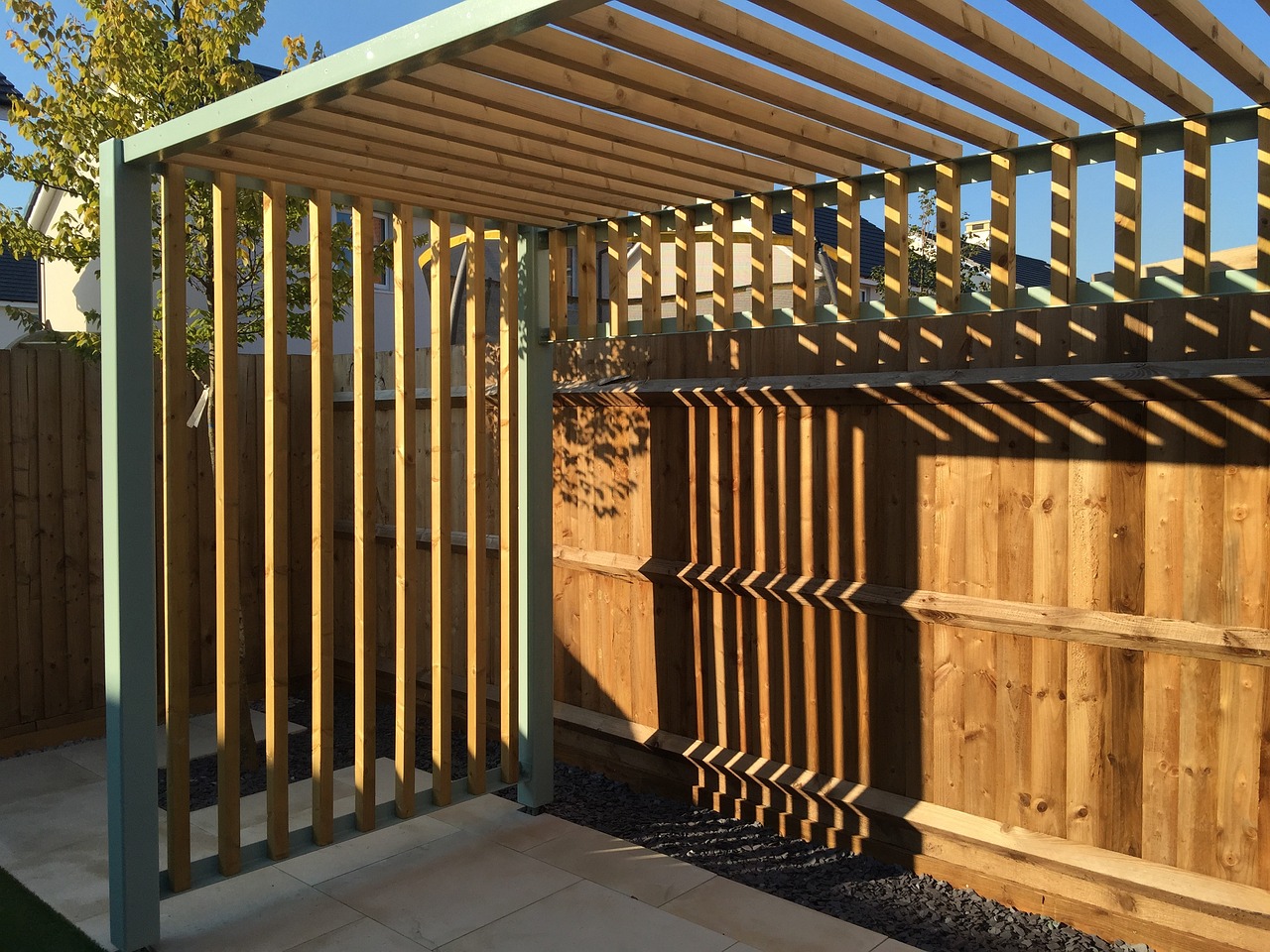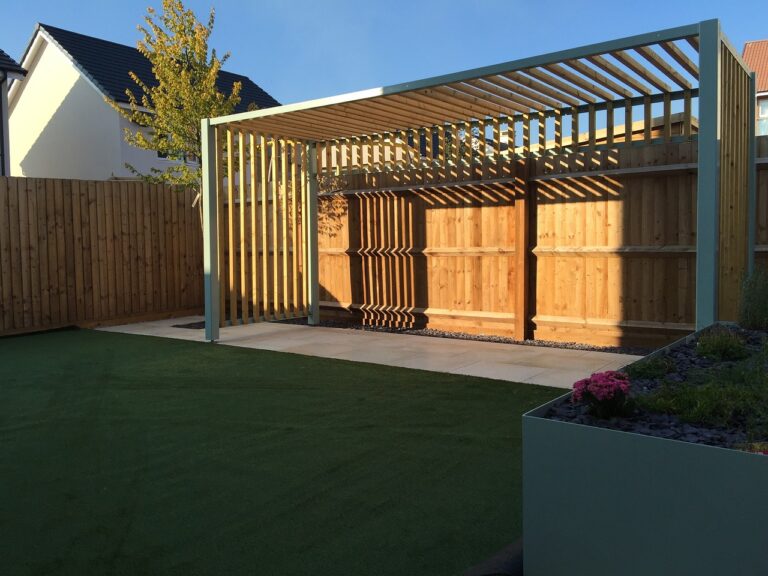To understand the topic of pergolas with or without a roof, let’s begin with an introduction to what a pergola actually is. This will lay the foundation for exploring the advantages and considerations associated with each option. So, let’s dive into the definition of a pergola and explore the contrasting perspectives regarding its roofing.
Definition of a pergola
A pergola is a structure created to add beauty to outdoor spaces. It has an open-roofed framework that supports climbing plants. This structure provides shade with natural light and air filtering through. It can be used in gardens, patios, and courtyards.
The craftsmanship of a pergola adds sophistication to a landscape. It becomes a focal point that offers privacy, but still has an open atmosphere. The lattice roof allows for partial shade, perfect for entertaining or relaxing.
The wide range of materials for constructing a pergola is impressive. From timber beams to metal structures, homeowners can choose the right fit for their style.
Pro Tip: Add lighting fixtures or hanging plants to the pergola. These will give your outdoor space a magical atmosphere during evenings, and add natural beauty!

Benefits of a pergola with a roof
To enhance your pergola with a roof, explore the benefits it brings. Gain protection from the elements, increased shade, and enhanced privacy. These advantages make your outdoor space more versatile and enjoyable, ensuring you can relax and entertain comfortably throughout the year.
Protection from the elements
A roofed pergola gives you protection from rain, sun, wind, and snow. You don’t have to cancel your outdoor plans due to bad weather. And, you’re safer from sunburns and overheating. It shields strong winds and prevents debris from flying around. Plus, it stops snow accumulating on furniture or items beneath the structure.
So, it’s worth investing in a pergola with a roof. You can use it year-round and make the most of your outdoor space. Plus, with glazing options, you get better insulation against heat and cold. And, adjustable louvers or retractable awnings let you control how much sunlight or airflow enters the space. Enjoy the outdoors comfortably, whatever the weather.
Increased shade
A roofed pergola provides many benefits:
- It guards from the sun’s UV rays, making skin safe from damage.
- The roof brings a cooler atmosphere, allowing you to use it during the day.
- Plus, your outdoor furniture will be preserved from fading and deterioration.
- Style and elegance is added without compromising on function.
- Coffee in the morning, evening gatherings – all enhanced by the shade.
Don’t miss out on your own shaded oasis – get a pergola with a roof today!
Enhanced privacy
Enhanced Privacy:
Gain a serene and secluded outdoor space with a pergola that has a roof. This addition can really boost privacy, making it the perfect choice for those who want privacy in their outdoor living area.
- Shield from prying eyes: The solid roof of a pergola gives protection from nosy neighbors or passersby. So, you can relax and enjoy your outdoor space without feeling watched.
- Lower noise levels: The roof shields against unwanted noise, creating a peaceful sanctuary from the hustle and bustle.
- Inviting gathering spot: With improved privacy, your pergola becomes an inviting place to entertain friends and family without worrying about nosy onlookers.
- Increased intimacy: Whether it’s a romantic dinner or an intimate conversation, the added privacy creates a more intimate atmosphere.
- Protection from elements: In addition to privacy, the roof offers protection from sun, rain, and other weather conditions. Meaning you can use your outdoor space throughout the year regardless of the weather.
- Customizable options: Choose different roofing materials such as polycarbonate panels or fabric shade sails to suit your style and desired level of privacy.
The benefits of enhanced privacy from a pergola with a roof are great. You can have a blissful oasis in your own backyard, free from prying eyes and noise disturbances. With protection from the elements and customizable options, you can craft a private retreat that fits your needs perfectly.
To further enhance privacy in your pergola with a roof, try these ideas:
- Build a privacy wall: Put screens or curtains around the sides of your pergola to block out unwanted views.
- Green it up: Incorporate plants and climbers to create a natural barrier that adds beauty and privacy.
- Install outdoor blinds: Get outdoor blinds you can pull down for maximum privacy.
By using these ideas, you can ensure maximum privacy in your pergola with a roof as well as adding aesthetic appeal. Take advantage of the versatility of a roofed pergola and turn your outdoor space into a private haven.

Benefits of a pergola without a roof
To enjoy the numerous benefits of a pergola without a roof, consider its open and airy design, allowing for a refreshing outdoor experience. With more natural light filtering through, you can create a space that brings you closer to nature. Additionally, the lack of a roof offers flexibility in design options, enabling you to personalize and adapt the pergola to suit your needs.
Open and airy design
Pergolas without roofs feature a unique open and airy design. This allows for ample ventilation and natural light, creating a fresh atmosphere. Plus, you can appreciate the beauty of the sky unobstructed.
These structures bring many benefits. Rainwater passes through freely, reducing the risk of damage or rot. You can also grow climbing plants or vines for a touch of greenery.
You can use a pergola without a roof in a variety of ways. On hot days, enjoy the cool breeze without direct sunlight. In colder months, more sunlight will reach your space, warming it up.
Install a pergola without a roof to experience the freedom it brings. Create an inviting atmosphere that blends with nature. Enhance your outdoor living experience and make lasting memories!
Allows for more natural light
Natural light is a must for any outdoor space, and having a pergola without a roof permits more of its beauty. Let’s look at why this is a plus.
- Cozier atmosphere: Without a roof, the area is more open and light-filled. This creates a warm, welcoming ambiance for entertaining or leisure.
- Vitamin D: Sunlight is a great source of vitamin D, which is key for our health. You can get more of it by allowing more natural light into your pergola.
- Closer to nature: With no roof, you can feel more a part of the natural environment. You can appreciate the beauty of your garden and landscape while still being sheltered from the sun.
Plus, with no roof, you can relish the fresh air and natural ventilation.
Plus, HomeAdvisor states that outdoor living spaces like pergolas can increase property value by up to 20%.
Flexibility in design options
When it comes to designing your pergola, there are plenty of options to choose from! Whether you like cozy and rustic or sleek and modern, the possibilities are endless! Select a small size for intimate gatherings or a large one if you’re a party-lover. You can pick wood for a warm touch, or metal for a stylish look. And don’t forget to add some character with decorative elements like climbing plants and hanging lights.
Have fun customizing the shape of your pergola – square, rectangular, or even curved. Now is your chance to create your dream outdoor retreat! Unleash your creativity and elevate the beauty of your outdoor space. Design your pergola today and start making lasting memories!
Factors to consider when deciding between a pergola with a roof or without a roof
To make an informed decision on whether to choose a pergola with a roof or without a roof, consider key factors. Take into account the climate and weather conditions, as well as your personal preferences and intended use. Additionally, budget considerations play a vital role. Collate these aspects, and choose the best option for your pergola.
Climate and weather conditions
Hot climates call for shade and protection from the sun. A pergola with a roof creates a cooler, more comfortable outdoor space.
Rainfall? Get a pergola with a roof! It’ll keep you and your furniture dry and prevent water damage.
Windy weather? A roof adds stability and reduces risk of damage.
Research your region’s climate and weather patterns to decide if a roof is needed for your pergola. It’s a pro tip!
Personal preferences and intended use
When it comes to picking a pergola, personal taste and use are key. Here are 4 points to consider:
- Privacy: A roofed pergola can give you the privacy you crave. But if you’re all for openness, an open-roofed one’s for you.
- Weather: If you’re looking for year-round use, a roofed pergola will keep you safe from rain and sun. But if you live in a mild climate, a no-roof option might be better.
- Style: A roofed pergola gives an elegant vibe, while an open-roof one gives off a natural, relaxed feel.
- Functionality: Consider how you’ll use your pergola. If you’re having parties outside, a roof will give you shade and protection from bad weather.
It’s important to remember that everyone’s different. My friend went for an open-roof pergola even though she lives in a place with unpredictable weather. She was worried about rain ruining her gatherings, but it ended up being a great experience. Her guests enjoyed snuggling under blankets during light showers and stargazing on clear nights.
In the end, your personal preferences and intended use all matter. Think about privacy, weather protection, style, and functionality to make the best choice for your lifestyle and outdoor space.
Budget considerations
When considering budget, it’s wise to weigh up the financial aspects of choosing between a pergola with a roof or none. Let’s look closer at key factors.
| Factor | Pergola with Roof | Pergola without Roof |
|---|---|---|
| Cost | More due to materials and roof installation | Less as no roof cost |
| Maintenance | May need more for roof repairs | Usually less as no roof |
| Use | Shade and protection from rain throughout the year | Limited in rainy seasons or bad weather |
A pergola without a roof may be cheaper at first, yet could limit use during certain times. But, if you’re on a budget and don’t mind occasional weather changes, it’s still a great option.
To make the most of your budget:
- Research materials: Compare prices and durability of different roofing materials.
- DIY or professional install: Assess your skills and willingness to do it yourself.
- Consider long-term costs: Examine potential maintenance and repair expenses in the future.
By looking over these factors and tips, you can make an informed decision that is budget-friendly and ensures maximum outdoor enjoyment!
Conclusion
To decide if a pergola is better with or without a roof, many things must be thought about. A roof gives shelter from bad weather, so you can use the outdoor area all year. It also keeps out the sun’s dangerous rays, making it more pleasurable. Plus, a roof makes the pergola look nicer.
Also, a roof lets you fit lighting or fans overhead. This can make a fantastic atmosphere for entertaining or enjoying quiet evenings. And, when needed, curtains or blinds can be added for privacy.
Historically, pergolas were open and didn’t have roofs. But, people started adding roofs to them for practical and fashionable reasons.
Frequently Asked Questions
FAQ: Is a pergola better with a roof or without a roof?
Q: What are the advantages of a pergola with a roof?
A: A pergola with a roof provides protection from the elements, such as rain and excessive sunlight. It creates a shaded area, making it more comfortable to enjoy the outdoors on hot days. It also helps to preserve any furniture or plants placed under it by shielding them from direct exposure to harsh weather conditions.
Q: What are the benefits of a pergola without a roof?
A: A pergola without a roof offers a more open and airy feel to the space. It allows natural light to filter through and provides an opportunity to enjoy the sky above. It is a great option for those who prefer an unobstructed view and want to create a more visually appealing structure. Additionally, it allows plants to receive direct sunlight, which can be beneficial for certain species.
Q: Can a pergola with a roof be used in all weather conditions?
A: While a pergola with a roof provides protection from most weather conditions, it may not be suitable for extreme weather situations such as heavy snowfall or strong winds. The roof material and design should be carefully chosen to ensure durability and proper drainage. It is recommended to consult with a professional or manufacturer to determine the suitability of a specific pergola design for different weather conditions.
Q: Are there any maintenance issues with a pergola without a roof?
A: Compared to a pergola with a roof, a pergola without a roof typically requires less maintenance. However, it is important to consider that without a roof, the structure may be more exposed to elements like leaves, debris, and bird droppings. Regular cleaning and maintenance may be needed to keep it looking its best. It is also important to note that certain plants growing on a pergola without a roof may require trimming and maintenance to prevent overgrowth.
Q: Can a pergola without a roof be converted to have a roof later on?
A: In many cases, a pergola can be retrofitted with a roof later on if desired. However, this will depend on the specific design and structure of the pergola. It is advisable to consult with a professional contractor or pergola manufacturer to assess the feasibility and potential cost of adding a roof to an existing pergola.
Q: Which option, a pergola with or without a roof, is more cost-effective?
A: The cost-effectiveness of a pergola with or without a roof depends on several factors, such as the type of materials used, roof design complexity, and personal preferences. Generally, a pergola without a roof tends to be less expensive as it requires fewer materials and labour. However, it is recommended to obtain quotes from multiple suppliers and contractors to compare costs and make an informed decision based on individual budget and requirements.
{
“@context”: “https://schema.org”,
“@type”: “FAQPage”,
“mainEntity”: [{
“@type”: “Question”,
“name”: “What are the advantages of a pergola with a roof?”,
“acceptedAnswer”: {
“@type”: “Answer”,
“text”: “A pergola with a roof provides protection from the elements, such as rain and excessive sunlight. It creates a shaded area, making it more comfortable to enjoy the outdoors on hot days. It also helps to preserve any furniture or plants placed under it by shielding them from direct exposure to harsh weather conditions.”
}
},
{
“@type”: “Question”,
“name”: “What are the benefits of a pergola without a roof?”,
“acceptedAnswer”: {
“@type”: “Answer”,
“text”: “A pergola without a roof offers a more open and airy feel to the space. It allows natural light to filter through and provides an opportunity to enjoy the sky above. It is a great option for those who prefer an unobstructed view and want to create a more visually appealing structure. Additionally, it allows plants to receive direct sunlight, which can be beneficial for certain species.”
}
},
{
“@type”: “Question”,
“name”: “Can a pergola with a roof be used in all weather conditions?”,
“acceptedAnswer”: {
“@type”: “Answer”,
“text”: “While a pergola with a roof provides protection from most weather conditions, it may not be suitable for extreme weather situations such as heavy snowfall or strong winds. The roof material and design should be carefully chosen to ensure durability and proper drainage. It is recommended to consult with a professional or manufacturer to determine the suitability of a specific pergola design for different weather conditions.”
}
},
{
“@type”: “Question”,
“name”: “Are there any maintenance issues with a pergola without a roof?”,
“acceptedAnswer”: {
“@type”: “Answer”,
“text”: “Compared to a pergola with a roof, a pergola without a roof typically requires less maintenance. However, it is important to consider that without a roof, the structure may be more exposed to elements like leaves, debris, and bird droppings. Regular cleaning and maintenance may be needed to keep it looking its best. It is also important to note that certain plants growing on a pergola without a roof may require trimming and maintenance to prevent overgrowth.”
}
},
{
“@type”: “Question”,
“name”: “Can a pergola without a roof be converted to have a roof later on?”,
“acceptedAnswer”: {
“@type”: “Answer”,
“text”: “In many cases, a pergola can be retrofitted with a roof later on if desired. However, this will depend on the specific design and structure of the pergola. It is advisable to consult with a professional contractor or pergola manufacturer to assess the feasibility and potential cost of adding a roof to an existing pergola.”
}
},
{
“@type”: “Question”,
“name”: “Which option, a pergola with or without a roof, is more cost-effective?”,
“acceptedAnswer”: {
“@type”: “Answer”,
“text”: “The cost-effectiveness of a pergola with or without a roof depends on several factors, such as the type of materials used, roof design complexity, and personal preferences. Generally, a pergola without a roof tends to be less expensive as it requires fewer materials and labour. However, it is recommended to obtain quotes from multiple suppliers and contractors to compare costs and make an informed decision based on individual budget and requirements.”
}
}]
}








